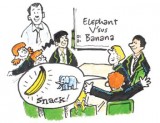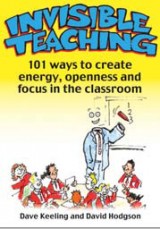Dave Keeling and David Hodgson present four activities that will make your classroom fizzle with an air of unseen energy...
Anyone who has seen The King’s Speech will have witnessed good teaching in action. Early in the film we are introduced to Lionel Logue, George VI’s unconventional speech therapist. At first his methods appear obscure, but Lionel understands that the relationship between the teacher and pupil and the environment in which the teaching takes place can be just as important as what is taught. Encouraging the king to roll on the floor, swear at the top of his lungs and sing may not, in and of itself, cure his stammer, but it does create a relaxed atmosphere and a bond of trust that allows progress to be made.
Working in schools across the country, Dave Keeling and David Hodgson have noticed a similar phenomenon, namely that great teaching and real learning always occurs when the ingredients of energy, openness and focus are present. These factors are often hidden from view but are fundamental to a successful classroom. Their latest book, Invisible Teaching, presents over 100 activities that empower all teachers to develop these unseen forces, a few of which we have included here so you can enjoy testing them out with your own class.
 Students attempt to beat the teacher in an energetic quick draw competition. (5 mins)
Students attempt to beat the teacher in an energetic quick draw competition. (5 mins)
This fast and quick energiser gets the whole group buzzing and focused for the beginning of a session.
The teacher invites the class to stand and make their hands into pretend guns which they must then place by their sides as if they were holstered. The teacher will then draw his or her guns accompanied with a very vocal ‘bang’. The object of the game is for the class to draw quicker than the teacher.
Great fun can be had by building the tension between each stand-off. For extra pleasure you may wish to experiment with a varying array of handlebar moustaches and Mexican costumes.
Students get to justify their decision making process in an open and focused thought-provoker. (5 mins)
I love this activity. I have deployed it a lot over the last few years and it never ceases to amaze me how well students can justify even the most bizarre argument. I usually begin with this in a session or employ it straight after break as a way of getting children’s minds focused back into class.
Begin by asking the students to shout out two random things, for instance:
 ELEPHANT AND BANANA
ELEPHANT AND BANANA
Then write the objects down on the board thus:
Elephant vs Banana
Challenge the group to chat in pairs and discuss which would win?
Be deliberately vague, as the students will have to decide what sort of contest it is. For instance, if it is simply a fight you may think the elephant has the advantage. But if it is about which one is better to nosh on after a long run then the banana may well inch it. As long as the students can justify their response, anything goes.
Remember to explain that children cannot get it wrong, they can only contribute. The great thing about human beings is that there will always be someone to disagree with and so the debate goes on.
This game sets thinking loose and, more importantly, encourages verbal reasoning and asks the question, why do you think like you do?
Everyone gets to sit down (all at once) through intuition and a bit of witchcraft. (5 mins)
It is always useful to have several techniques up your sleeve to calm a class and encourage focus. There is no point attempting to teach if half the children are still thinking about break time or what’s for lunch.
Ask the entire class to stand up, face front and close their eyes. You then explain that when (and only when) the whole class is ready, everyone will attempt to sit down at the same time. If people sit down at irregular intervals, the game starts again. It’s a good idea to let the children keep their eyes open to begin with until they are comfortable with the idea.
When you first try this activity it’s likely that some students will be impatient and attempt to force the sit. Others will get lost in a form of upright daydreaming. But if your group is working well together, listening intently and sensing the mood of the room, you will – on occasion – have a moment where everyone works together and the children all sit down at the same time. It is worth reminding ourselves that learning is not always just about the individual, it’s about the group. And when a group works well great things can happen.
Students attempt to match a sequence of words with specific movements. (10 mins)
A group is challenged to learn a sequence of movements associated with different forms of transport.
• Canoe (paddling action)
• Plane (arms out like wings)
• Car (holding a steering wheel and moving it back and forth)
• Train (tugging bell and saying, ‘Choo choo’)
• Bungee (jumping up and down three times)
Once these have been mastered, swap two of the movements around (e.g., so ‘Canoe’ becomes jumping up and down three times and ‘Bungee’ becomes a paddling action). Alternatively, usethe game to demonstrate how we can learn more information if we add movements and fun to the learning process.
 Develop a spirit of energy and openness in your classroom…
Develop a spirit of energy and openness in your classroom…
Invisible Teaching (ISBN 9781845906856, £12.99, Crown House Publishing) is due out in May. The book will also be available to buy together with a teacher training DVD that demonstrates how the activities can be used within your school (ISBN 9781845907183, £60, Crown House Publishing). For further details or to book Dave and David for a training event at your school, contact Crown House Publishing, .(JavaScript must be enabled to view this email address)
David Hodgson does great work with young people and those who work with them on motivation, goal setting, life skills and employability. His entertaining delivery is fast paced, relevant and effective.
Dave Keeling has been a professional actor for 15 years and a ‘stand-up’ educationalist (or kinesthetic and passionate) for 10 years, working the length and breadth of the country with teachers, pupils and parents.
How children react to a moral dilemma may be down to your teaching
Ace-Classroom-Support
Should you let educational researchers into your classroom?
Ace-Classroom-Support
